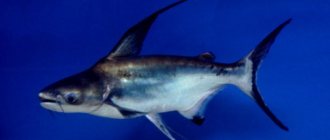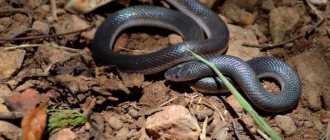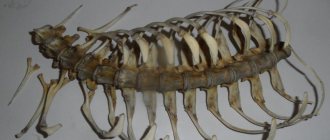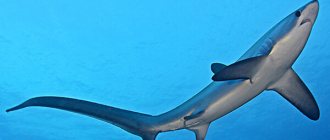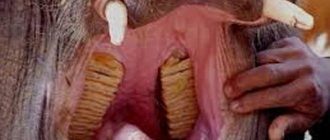21 January191aquatic life sharks are dangerous
The hammerhead shark is a fascinating and terrifying sea creature. There are several species of hammerhead sharks, some of which are deadly to humans, while others, on the contrary, are absolutely harmless. In this article you will learn all about the giant hammerhead shark, and also read about other types of hammerhead sharks.
Why does a hammerhead shark have such a strange head?
At the moment, there is no final hypothesis as to why such a genetic mutation occurred and why the hammerhead shark needs such a head is not clear. Fossil remains of their skeletons are not preserved, because their bones are highly mineralized, and only their teeth are preserved in good condition. Therefore, it is impossible to trace changes since ancient times.
But the hammerhead gives sharks a number of advantages. Firstly, with this head they can strike, pin or push prey. Secondly, it is an all-round view of almost 360 degrees. The only area that is poorly visible is right in front of them. Therefore, in order to assess the situation, the hammerhead shark often swims in a circle and from side to side.
Another interesting question is whether a shark's hammer is bone or cartilage? Of course, the hammer on the shark's head is made of bone tissue. These sharks have an interesting skull shape with bony processes on the sides on which the eyes are located. So the hammer of hammerhead sharks is nothing more than a part of their skull.
The hammerhead also carries a number of disadvantages for these sharks. The bone tissue on the head is susceptible to fractures. And because of the shape of their heads, these sharks easily get tangled in fishing nets and die.
Breathe to live
Sharks, like all fish, need oxygen, which they get from water passed through their gills.
The respiratory organs of a shark are gill sacs, with internal openings going into the pharynx, and external openings onto the surface of the body (on the sides of the head). Biologists count from 5 to 7 pairs of gill slits in different species, located in front of the pectoral fins. When breathing, blood and water move in countercurrent .
This is interesting! In bony fishes, water washes the gills due to the movement of the gill covers, which are absent in sharks. Therefore, cartilaginous fish drive water through the lateral gill slits: it enters the mouth and flows out through the slits.
To prevent breathing from stopping, the shark must continuously move with its mouth open. Now it’s clear why sharks placed in a small pool flap their mouths slightly open: they lack movement, and therefore oxygen.
Return to content
What types of hammerhead sharks are there?
The hammerhead shark family is small. There are only 9 species of hammerhead sharks . Let's list them:
- The roundhead hammerhead is the smallest member of the hammerhead shark species. Its length does not exceed 92 cm. The hammer is of medium size and makes up about 25% of the length of its body, which is approximately 24-27 cm. The fish is quite rare and poorly studied. The head is rounded, which is where it gets its name. They stay close to the shore at depths of up to 100 meters. They feed on crustaceans, cephalopods and small fish. There is no danger to humans.
- Small-eyed Hammerhead Shark - The name of this shark is misleading, because it is not giant at all, but on the contrary, one of the smallest representatives of the hammerhead shark species. The average body length is 1.2-1.3 m, the maximum recorded size was 1.5 m. It is recognizable and easily distinguishable from other species by color. The back is usually gray in color, while the sides, hammer and belly are yellow or even orange in color and shiny. Because of this, fishermen call this shark the “golden hammer”.
- The smallhead hammerhead has the smallest hammerhead of all hammerhead shark species. But the hammer is quite wide, which is why it is also called the shovel shark. The maximum recorded body length was 1.5 m, but the average size of this shark does not exceed a meter. The fish is very active, gathers in schools of several dozen individuals, less often schools can number in the hundreds, and some sources describe schools of thousands of these sharks.
- Panamo-Caribbean hammerfish - has a wide, curved and not long hammer. Body length does not exceed 1.5 meters. It has teeth with thin and long points without serrations. The color of the back is gray-brown, the belly is light. It feeds on fish, squid, and octopus. It can gather in schools, and with representatives of other species of hammerhead sharks. Potentially hazardous to humans. The species is poorly studied.
- The big-headed hammerfish has the most unusual and disproportionate appearance. The body is thin, does not exceed 2 m in length. The size of the hammer in relation to the body is the largest and amounts to up to 50% of the body length. Because of this, it is easy to distinguish from other species of hammerhead sharks. The back is gray, sometimes with a brownish tint. The belly is light. The bighead hammerhead fish does not pose a danger to humans.
- Bronze Hammerhead Shark - These sharks are most often found at depths of 25 m, but they have been spotted at depths of up to 1 km. The longest recorded body length was 4.3 m with a body mass of over 152 kg. They have a wide hammer, curved at the edges. They can gather in fairly large flocks. Over the past 40 years, the number of these sharks has decreased by 95% due to poaching and they have received the status of an “Endangered” species. Potentially dangerous to humans, although they exhibit a calm and timid disposition when they see scuba divers.
- Carolina hammerhead shark - has a body length of up to 4 meters. It was classified as a separate species only in 2013. It lives off the coast of Carolina in the Western Atlantic Ocean, which is where it got its name. It feeds on fish and crustaceans. They also have protected status and are endangered due to poaching.
- The common hammerhead shark is one of the largest species of hammerhead sharks. The longest recorded body length was 5 m and the mass was 400 kg. They have a very widespread habitat, live and are found in almost all warm and temperate waters of the world's oceans. They prefer to stay near the surface of the water and are rarely found at depths of more than 20 m.
- The basking hammerhead shark is the largest hammerhead shark of all species. You will learn all the details about it further in the article.
Absolutely not dangerous to humans, not aggressive. They have commercial importance and are often targeted by fishermen, which is why they received the status of “Vulnerable” species.
The smallhead hammerhead fish feeds on crustaceans, small fish, mollusks and shrimp. At the beginning of the mouth of this shark there are small and sharp teeth that help to grab and hold food, and in the depths there are wide and flat teeth that easily grind the crab’s shell. There is no danger to humans. These sharks are often kept in aquariums and oceanariums. Has commercial significance. The species is not rare; their numbers are significant due to their rapid reproductive cycle.
They have a medium sized hammer. There are a lot of teeth in the mouth. The lower jaw has 25 to 30 rows of teeth, and the upper jaw has 26 to 32 rows. The teeth are triangular in shape with slightly jagged edges. It feeds on various fish, cephalopods and sharks, sometimes even of its own species.
Individuals of the common hammerhead shark can form schools of several dozen. Although young individuals can form flocks of several hundred. A flock of more than a thousand individuals has been recorded off the coast of California. They gather in schools during summer migrations to cooler waters.
The common hammerhead shark is of industrial importance. Their meat is used for food, soup is made from their fins, and vitamins are made from fat. The young hammerhead shark becomes prey to larger predators, such as the dusky shark or killer whale. The numbers of this species are constantly declining and are assessed as vulnerable. For humans, the common hammerhead shark poses a serious threat.
Carpet shark or bearded wobbegong
Agree, it doesn’t look like a shark at all. These bottom-dwelling marine animals, common in warm waters, grow to a length of just over a meter, but sometimes three-meter-long individuals are also found. The wobbegong's body is flat, widening towards the head with a rather unattractive snout, expressionless unblinking eyes, small teeth and skin growths reminiscent of a beard. With them, the carpet shark “combs” the seabed, looking for food - crabs, shrimp, mollusks, echinoderms and small fish. The spotted skin allows the bearded wobbegong to camouflage well on the bottom, blending in with corals and algae.
Interesting fact. Almost all shark species need to move in order to breathe. Wobbegongs can breathe without moving. These are sedentary animals. Consequently, they burn fewer calories, so they need little food.
Carpet sharks are not dangerous to people, although you should not touch them or grab them by the tail - they can bite.
What does a giant hammerhead shark look like?
The giant hammerhead shark looks very scary. Previously, before scientific research, it was believed that the hammerhead shark was the most dangerous and bloodthirsty shark. Of course, this is not entirely true, but the giant hammerhead shark is indeed very dangerous to humans and is an extremely aggressive predator.
The body of the giant hammerhead shark is elongated and streamlined. The color of the back can be light gray, olive, brown. The belly is always light. In adults, the fins are colored in the color of the back, while in juveniles they are darker in color or have a border. The dorsal fin is very high, sickle-shaped. The skin is covered with densely arranged diamond-shaped scales with teeth at the end.
The giant hammerhead shark, like all representatives of this species, has a hammer-shaped head. In relation to the body, the hammer is not the largest and makes up on average 25% of the total body length. But in fact, if we take into account that the size of these sharks often exceeds 5 meters, then their hammer will have significant dimensions - 1-1.5 m. The hammer is straight in shape.
These hammerhead sharks are called giant sharks for a reason. The average body length of an adult is 3.5 m, and the weight is about 250 kg. However, this is far from the limit. An individual measuring 7.89 m long and weighing 363 kg was caught off the coast of New Zealand in 2011. A pregnant female with a body length of 5.5 m and weighing more than 580 kg was caught in Florida.
One of the most interesting questions is how many teeth does a giant hammerhead shark have? This shark has a lot of teeth. The upper jaw has 17 rows of teeth on each side and 16-17 teeth in the lower jaw on each side. The teeth of the giant hammerhead shark are triangular in shape with jagged edges.
The giant hammerhead shark lives up to 50 years, but the average life expectancy is 25 years.
What are gills?
This is also a simple question for the average person. Anyone will say that these are organs designed for breathing in water, and they will be right. These are respiratory surfaces turned outward, equipped with a huge number of very thin blood capillaries, in which gas exchange occurs.
Some marine worms and all mollusks and crayfish have gills. In vertebrates, gills are slits in the pharynx, equipped with a large number of projections.
We all also once had gills - in the first month of embryonic development.
Where does the hammerhead shark live?
Hammerhead sharks live in all warm waters of the world's oceans. They mostly stay on coastal shelves, but also swim into open waters. Unlike most species of sharks, hammerhead sharks not only live alone, but also form schools. Especially during migrations. Some species migrate to colder waters during the summer heat. The basking hammerhead shark is found throughout tropical and warm temperate waters. It can be found in the Indian, Pacific and Atlantic oceans, the Caribbean and Mediterranean seas.
The giant hammerhead shark lives almost throughout the entire coastal part of Africa, off the Western, Northern and Eastern coasts of Australia. In America, from the Atlantic Ocean, it is found from North Carolina to Uruguay. On the Pacific side, the giant hammerhead shark lives from Los Angeles to the coast of Peru.
Habitats
There are plenty of places on earth where sharks live. They are especially common in the waters of the equator and the seas adjacent to it, in reefs and water areas off the coast.
Some types of sharks are able to live in any water, such as gray and blunt-snout sharks. A comfortable depth for them is about 2000 m, sometimes 3000 m.
Who does the hammerhead shark hunt and what does it eat?
The diet of the giant hammerhead shark is varied. It eats fish such as horse mackerel, mackerel, sardine and others. The hammerhead shark hunts squid and cuttlefish, eats crabs and lobsters. This shark's diet also includes other, smaller sharks such as the dusky gray shark or the common mustel shark. There are also cases of cannibalism; larger individuals eat young ones.
The favorite delicacy of the giant hammerhead shark is stingrays. She hunts stingrays without any embarrassment that they have poisonous spines. A caught specimen was described as having about a hundred sea cat spines sticking out of its mouth. Most likely, the poisonous spines do not cause much discomfort to these sharks.
The hammerhead shark's method of hunting stingrays is quite interesting. She runs in circles exploring the bottom. Having noticed a stingray, she strikes it with lightning speed with her bony head. And then he bites off one or both wings at once, thereby immobilizing him. After this, the prey is torn into pieces and eaten.
Many stingrays are well camouflaged and blend into the bottom. However, the giant hammerhead shark has no problem finding and eating them. From this we can conclude that this shark has fairly good eyesight. Also, these sharks often get caught on a hook with bait, which leads to another conclusion - these sharks have an excellent sense of smell.
Predator feeding
Each species has its own diet and preferences. But most prefer the fish assortment. Deep-sea species feed on crabs and other crustaceans.
White sharks even prefer seals, fur seals and cetaceans, while tiger sharks consume everything indiscriminately. They feed on plankton and small things: largemouth, whale, giant.
Hammerhead shark breeding
Giant hammerhead sharks reach sexual maturity when males are 2.3-2.7 m in size and weigh 50 kg, and females are 2.5-3 m in body length and weigh more than 40 kg. Unlike most sharks, which mate on the bottom, hammerhead sharks mate near the surface of the water. Another interesting feature is that, like the Komodo dragon, females are capable of parthenogenesis, reproduction without the participation of a male, passing only their DNA to the offspring.
The female bears offspring once every two years. Pregnancy lasts 11 months. The basking hammerhead shark, like other hammerhead sharks, is viviparous. There are from 6 to 55 cubs in a litter, and their body length does not exceed 7 cm.
Is the basking hammerhead shark dangerous to humans?
The giant hammerhead shark is dangerous to humans because it is enormous in size and has many teeth. Usually, when they see divers, these sharks do not behave aggressively and even timidly, showing no curiosity towards people at all. However, cases were described when the shark began to move with sudden jerks and even attacked swimmers.
Human remains have been found in the stomach of this species. As of 2011, the registry of shark attacks on humans included 34 attacks by hammerhead sharks, one attack even resulted in a fatal outcome. Unfortunately, it is impossible to determine exactly how many attacks the giant hammerhead shark has made due to the difficulty of identifying species. However, if we consider that two other species of hammerhead sharks pose a real danger to humans, then we can assume that some of these recorded attacks are definitely due to the giant hammerhead shark.
The basking hammerhead shark is a common target of recreational and commercial fisheries. She often gets caught in fishing nets, gets entangled and dies in anti-shark nets. It becomes a target for poachers because of its fins, which are used to make a delicious soup. Medicines are made from the skin and liver, and fishmeal is made from meat. All this has led to the fact that the number of individuals of the giant hammerhead shark is steadily declining. Also, a slow reproductive cycle does not contribute to population growth.
Due to the rapid decline in the number of the basking hammerhead shark, the European Union, Australia and the United States have banned the harvesting of shark fins. But, unfortunately, no other steps are being taken to preserve the species. The great hammerhead shark is now classified as an endangered species.
Don’t forget to subscribe to updates on our website and join us on social networks (Vkontakte, Odnoklassniki, Instagram) so you don’t miss anything and always stay up to date with all the news!
Don't forget to share with your friends!
